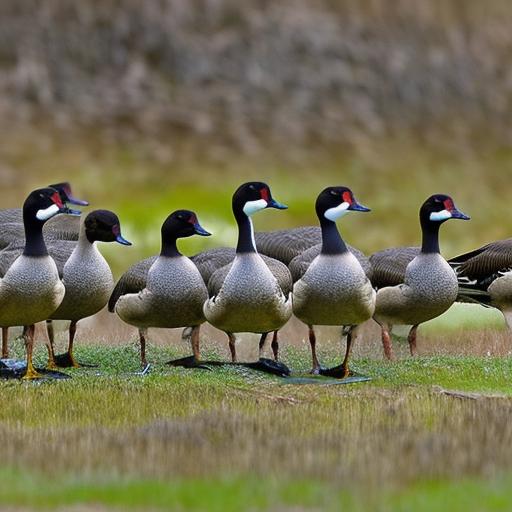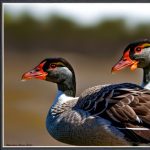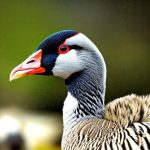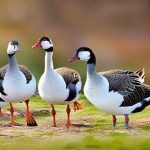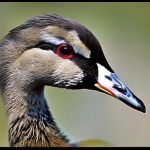Canada geese are known for their distinctive honking calls and V-shaped flying formations, but they are also fascinating creatures when it comes to their breeding season. The breeding season for Canada geese typically begins in late winter or early spring, depending on the region. During this time, these majestic birds engage in a variety of behaviors, from courtship rituals to nest building and raising their young. Understanding the breeding season of Canada geese is crucial for conservation efforts and for appreciating the natural world around us.
Nesting Habits of Canada Geese
During the breeding season, Canada geese are known for their impressive nest-building skills. They typically build their nests in a variety of locations, including on the ground, in tall grass, or even on man-made structures such as rooftops or platforms. The female goose will lay a clutch of eggs, usually around 5 to 7, and both parents take turns incubating the eggs. The nests are often lined with down feathers plucked from the parents’ own bodies, providing warmth and protection for the developing embryos. Once the goslings hatch, they are precocial, meaning they are able to leave the nest and feed themselves shortly after hatching.
Courtship and Mating Rituals
Canada geese are known for their elaborate courtship and mating rituals during the breeding season. These rituals often involve elaborate displays of affection and bonding between mated pairs. The male goose will often perform a variety of displays, including head bobbing, honking, and wing flapping, to attract a mate. Once a pair has bonded, they will often engage in synchronized swimming and other displays of affection. These rituals are not only fascinating to observe but also play a crucial role in the reproductive success of Canada geese.
The Role of Both Parents in Raising Goslings
Once the goslings have hatched, both parents play an active role in raising and protecting their young. The parents will lead their goslings to feeding areas, teaching them how to forage for food and providing protection from predators. Canada geese are known for their strong family bonds, and both parents are fiercely protective of their young. They will often use their bodies to shield the goslings from harm and will aggressively defend their offspring if they perceive a threat. This level of parental care is crucial for the survival of the goslings during their early days.
Challenges Faced During Breeding Season
The breeding season for Canada geese is not without its challenges. One of the biggest threats to breeding success is habitat loss and degradation. As human development continues to encroach on natural habitats, Canada geese are forced to adapt to new environments, which can impact their ability to successfully breed. Additionally, predation from animals such as foxes, raccoons, and birds of prey can pose a significant threat to goslings. Climate change and extreme weather events can also impact breeding success, as changing temperatures and precipitation patterns can affect food availability and nesting sites.
Migration Patterns and Breeding Grounds
Canada geese are known for their impressive migration patterns, traveling thousands of miles between their breeding and wintering grounds. Many Canada geese breed in the northern regions of North America, including Canada and Alaska, before migrating south for the winter. During the breeding season, these birds are often found in wetland areas, where they can find ample food and nesting sites. Understanding the migration patterns and breeding grounds of Canada geese is crucial for conservation efforts, as it allows researchers to identify key areas for protection and management.
Impact of Human Interaction on Canada Geese Breeding
Human interaction can have a significant impact on Canada geese during the breeding season. Disturbance from human activities, such as boating, fishing, and recreational activities, can disrupt nesting and feeding behaviors, leading to decreased breeding success. Additionally, habitat destruction and pollution can further impact the ability of Canada geese to successfully breed. It is important for humans to be mindful of their impact on these birds and to take steps to minimize disturbance during the breeding season.
Conservation Efforts to Protect Canada Geese During Breeding Season
Conservation efforts are crucial for protecting Canada geese during the breeding season. This includes habitat restoration and protection, as well as the implementation of regulations to minimize disturbance during the breeding season. Many organizations and agencies work to monitor Canada geese populations and implement management strategies to ensure their long-term survival. By understanding the needs of Canada geese during the breeding season, conservationists can work to protect key habitats and minimize threats to these iconic birds.
Interesting Facts and Behaviors of Canada Geese During Breeding Season
During the breeding season, Canada geese exhibit a variety of interesting behaviors and adaptations. For example, they are known for their strong family bonds and will often stay together in family groups throughout the year. They are also highly adaptable birds, able to thrive in a variety of habitats, from urban parks to remote wetlands. Additionally, Canada geese are known for their impressive flying formations, which allow them to conserve energy during long migrations. These behaviors and adaptations make Canada geese a truly remarkable species to observe and study.
The Importance of Understanding and Protecting Canada Geese During Breeding Season
In conclusion, the breeding season of Canada geese is a critical time for these iconic birds. Understanding their nesting habits, courtship rituals, and challenges they face is crucial for conservation efforts and for appreciating the natural world around us. By taking steps to protect their habitats and minimize disturbance during the breeding season, we can ensure the long-term survival of Canada geese for future generations to enjoy. It is important for humans to be mindful of their impact on these birds and to take steps to minimize disturbance during the breeding season. Through conservation efforts and a greater understanding of their behaviors, we can work to protect and preserve Canada geese for years to come.
Meet Walter, the feathered-friend fanatic of Florida! Nestled in the sunshine state, Walter struts through life with his feathered companions, clucking his way to happiness. With a coop that’s fancier than a five-star hotel, he’s the Don Juan of the chicken world. When he’s not teaching his hens to do the cha-cha, you’ll find him in a heated debate with his prized rooster, Sir Clucks-a-Lot. Walter’s poultry passion is no yolk; he’s the sunny-side-up guy you never knew you needed in your flock of friends!

